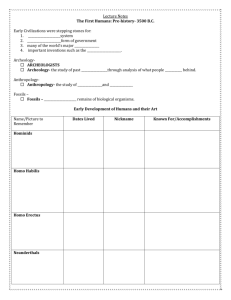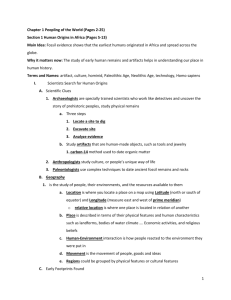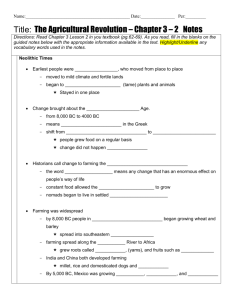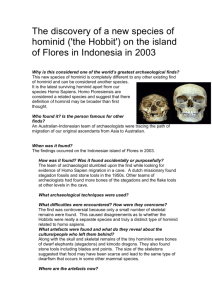Middle Ages and Renaissance
advertisement
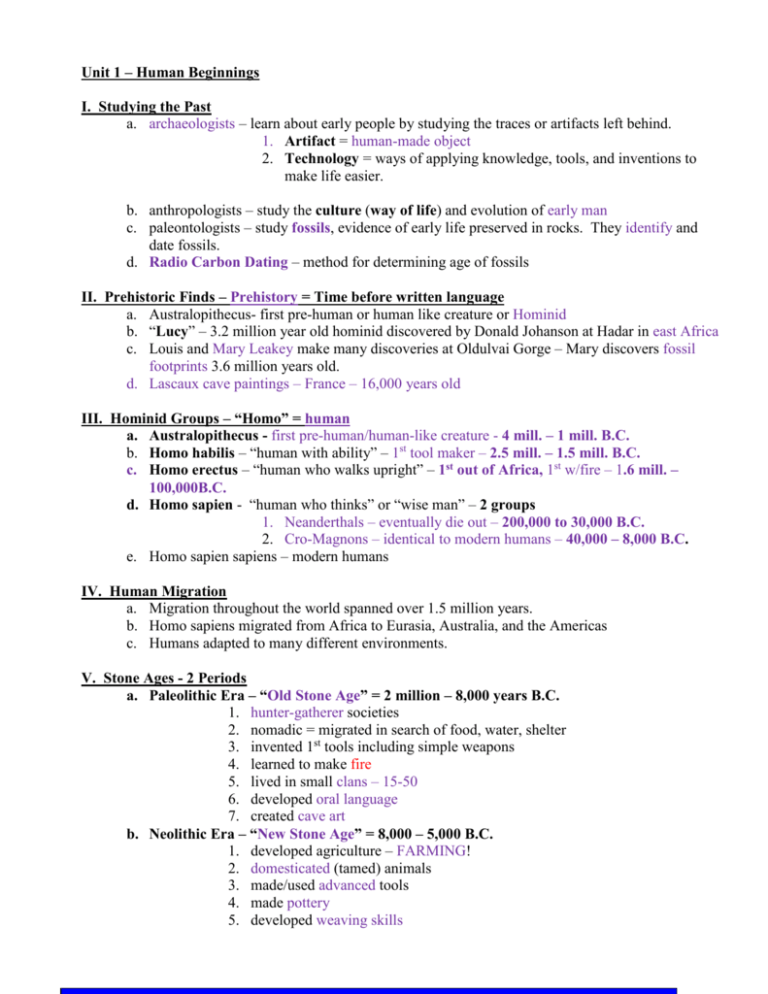
Unit 1 – Human Beginnings I. Studying the Past a. archaeologists – learn about early people by studying the traces or artifacts left behind. 1. Artifact = human-made object 2. Technology = ways of applying knowledge, tools, and inventions to make life easier. b. anthropologists – study the culture (way of life) and evolution of early man c. paleontologists – study fossils, evidence of early life preserved in rocks. They identify and date fossils. d. Radio Carbon Dating – method for determining age of fossils II. Prehistoric Finds – Prehistory = Time before written language a. Australopithecus- first pre-human or human like creature or Hominid b. “Lucy” – 3.2 million year old hominid discovered by Donald Johanson at Hadar in east Africa c. Louis and Mary Leakey make many discoveries at Oldulvai Gorge – Mary discovers fossil footprints 3.6 million years old. d. Lascaux cave paintings – France – 16,000 years old III. Hominid Groups – “Homo” = human a. Australopithecus - first pre-human/human-like creature - 4 mill. – 1 mill. B.C. b. Homo habilis – “human with ability” – 1st tool maker – 2.5 mill. – 1.5 mill. B.C. c. Homo erectus – “human who walks upright” – 1st out of Africa, 1st w/fire – 1.6 mill. – 100,000B.C. d. Homo sapien - “human who thinks” or “wise man” – 2 groups 1. Neanderthals – eventually die out – 200,000 to 30,000 B.C. 2. Cro-Magnons – identical to modern humans – 40,000 – 8,000 B.C. e. Homo sapien sapiens – modern humans IV. Human Migration a. Migration throughout the world spanned over 1.5 million years. b. Homo sapiens migrated from Africa to Eurasia, Australia, and the Americas c. Humans adapted to many different environments. V. Stone Ages - 2 Periods a. Paleolithic Era – “Old Stone Age” = 2 million – 8,000 years B.C. 1. hunter-gatherer societies 2. nomadic = migrated in search of food, water, shelter 3. invented 1st tools including simple weapons 4. learned to make fire 5. lived in small clans – 15-50 6. developed oral language 7. created cave art b. Neolithic Era – “New Stone Age” = 8,000 – 5,000 B.C. 1. developed agriculture – FARMING! 2. domesticated (tamed) animals 3. made/used advanced tools 4. made pottery 5. developed weaving skills VI. The Neolithic Revolution! = The Agricultural Revolution *** Neolithic Revolution = the far-reaching changes in human life caused by the beginning of farming. a. Causes of the NR 1. rising temps. caused pop. growth – new food sources needed 2. farming provided steady food source b. Early farming method 1. slash and burn – burn trees = clears and fertilizes fields c. domestication of animals – taming of animals for human purposes 1. dogs, goats, pigs, and sheep were first 2. pastoral nomads – continually moved herds to new pastures + water VII. Villages Grow and Prosper a. Farming develops independently in many regions around the world. b. First in the Middle East – Jarmo and Catal Huyuk c. soon after in Egypt, South and East Asia, and Americas VIII. Villages Grow Into Cities a. Improved farming techniques supported drastic population growth b. Trade, specialization, cooperation increased c. Social classes and organized religion emerges d. Civilization develops!!! IX. What Makes a Civilization? a. Civilization = complex culture with five characteristics 1. advanced cities – large pop., & centers of trade 2. specialized workers – skills in a specific kind of work a. metalworkers, weavers, potters, scribes, merchants b. artisans – make goods by hand 3. complex institutions = long-lasting pattern of organization a. government, religion, education, military, economy 4. record keeping – needed to document institutional records 5. advanced technology – new tools, techniques to make life easier X. Where Did the earliest Civilizations Develop? a. They developed in river valleys!! 1. Mesopotamia/Sumer – Tigris and Euphrates River Valleys 2. Egypt – Nile River Valley 3. India – Indus River Valley 4. China – Huang He River Valley b. Why in river valleys?? 1. river valleys offered rich soils for farming 2. abundance of water for large scale irrigation 3. tended to be in areas easily protected from nomadic invaders
